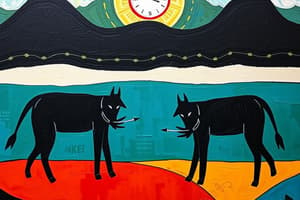Podcast
Questions and Answers
What perspective does Derek Mahon use in 'After the Titanic'?
What perspective does Derek Mahon use in 'After the Titanic'?
- First-person perspective of a survivor
- Third-person perspective of the Titanic
- First-person perspective of J. Bruce Ismay (correct)
- Third-person perspective of the crew
What does the phrase 'pandemonium of prams’ represent in the poem?
What does the phrase 'pandemonium of prams’ represent in the poem?
- The laughter of children
- The loss of innocent lives (correct)
- The chaos of the lifeboats
- The joy of the passengers
What does Ismay's retreat to a 'lonely house behind the sea' signify?
What does Ismay's retreat to a 'lonely house behind the sea' signify?
- Desire for isolation and peace
- Guilt and trauma from the past (correct)
- Avoidance of the media
- A search for redemption
How does Mahon's use of the word 'sank' impact the reader's perception of Ismay?
How does Mahon's use of the word 'sank' impact the reader's perception of Ismay?
What does the imagery of 'broken toys and hatboxes' symbolise in Ismay's narrative?
What does the imagery of 'broken toys and hatboxes' symbolise in Ismay's narrative?
Which aspect of the natural images listed in the poem portrays Ismay's sense of despair?
Which aspect of the natural images listed in the poem portrays Ismay's sense of despair?
What does Ismay's plea to be included in 'lamentations' suggest about his character?
What does Ismay's plea to be included in 'lamentations' suggest about his character?
Which figurative language is used to illustrate Ismay's emotional state after the sinking?
Which figurative language is used to illustrate Ismay's emotional state after the sinking?
Which theme is NOT explicitly explored in 'After the Titanic'?
Which theme is NOT explicitly explored in 'After the Titanic'?
What effect does the use of enjambment and caesura have in the poem?
What effect does the use of enjambment and caesura have in the poem?
What does Ismay plead for in his reflections?
What does Ismay plead for in his reflections?
What does Ismay's description of his home imply about his state of mind?
What does Ismay's description of his home imply about his state of mind?
What is one of the key emotional responses expressed by Ismay in the poem?
What is one of the key emotional responses expressed by Ismay in the poem?
Which phrase best describes Mahon’s overall approach to Ismay’s character?
Which phrase best describes Mahon’s overall approach to Ismay’s character?
Flashcards
J. Bruce Ismay
J. Bruce Ismay
The Managing Director of White Star Line during the Titanic disaster.
Titanic Disaster
Titanic Disaster
A tragic event describing the sinking of the Titanic in 1912.
Ismay's Perspective
Ismay's Perspective
Ismay's personal account and feelings related to the event, expressed by Derek Mahon.
Outsider (in poem)
Outsider (in poem)
Signup and view all the flashcards
Consideration of Villainy
Consideration of Villainy
Signup and view all the flashcards
Emotional toll of survival
Emotional toll of survival
Signup and view all the flashcards
Guilt and Remorse
Guilt and Remorse
Signup and view all the flashcards
Emotional Unraveling
Emotional Unraveling
Signup and view all the flashcards
Poem's Purpose
Poem's Purpose
Signup and view all the flashcards
Study Notes
Overview of "After the Titanic"
- J. Bruce Ismay was Managing Director of the White Star Line during the Titanic disaster on April 14, 1912.
- Ismay, vilified for surviving, secured a place in a lifeboat while many perished.
- Derek Mahon gives Ismay a first-person voice, allowing him to share his perspective and suffering.
Themes
- Consideration of the Outsider: Explores Ismay’s experiences as an outcast after the tragedy.
- Consideration of the Villain: Challenges the notion of villainy surrounding Ismay’s actions during the disaster.
- Human Suffering: Addresses the emotional and psychological toll of survival amidst tragedy.
- Death and Destruction: Reflects on the catastrophic loss of life and the resulting chaos.
- Morality and Decision-Making: Questions the ethical implications of Ismay's choices during the catastrophe.
Stylistic Elements
- Voice: Uses Ismay's perspective to evoke empathy despite his controversial actions.
- Imagery: Employs vivid and stirring descriptions to illustrate Ismay's emotional state and memories.
- Figurative Language: Incorporates similes, metaphors, and personification to convey complex feelings.
- Sound Effects: Utilises sibilance and alliteration for rhythmic effect.
- Structure: Features enjambment and caesura for dramatic pauses and flow.
Analysis of Key Passages
- Ismay's defensive tone reveals his bitterness over public perception and inquiry findings.
- He claims, “I sank as far that night as any Hero,” emphasising his internal struggle and desire for sympathy against the backdrop of mass tragedy.
- The metaphor of turning to ice conveys the emotional paralysis in witnessing the ship’s destruction while being physically safe.
- The chaotic imagery of “pianos, sideboards, winches” symbolizes the sudden shift from normalcy to disaster.
Ismay’s Isolation and Guilt
- Ismay retreated to a lonely home, haunted by memories and guilt symbolised by "broken toys and hatboxes" left by the tide.
- Nature's indifference ("showers of April, flowers of May") contrasts Ismay’s inner turmoil, highlighting his inability to move on.
- The reference to his gardener illustrates how Ismay is viewed by others and his own self-imposed isolation, marked by substance use and withdrawal.
Emotional Unraveling
- Ismay’s reminiscence evokes pity as he concedes to recurring nightmares of drowning, haunted by the faces of those he could not save.
- The metaphor of “my heart breaks loose and rolls down like a stone” signifies the weight of everlasting guilt and remorse.
- His plea to be included in lamentations reveals vulnerability and a desire for recognition of his suffering alongside the victims.
Conclusion
- Mahon’s portrayal of Ismay invites readers to reconsider the complexities of villainy, survival, and guilt in the context of a historical tragedy.
- The poem challenges readers to empathise with a figure often unjustly condemned, showcasing the deep emotional scars left by collective loss.
Studying That Suits You
Use AI to generate personalized quizzes and flashcards to suit your learning preferences.




